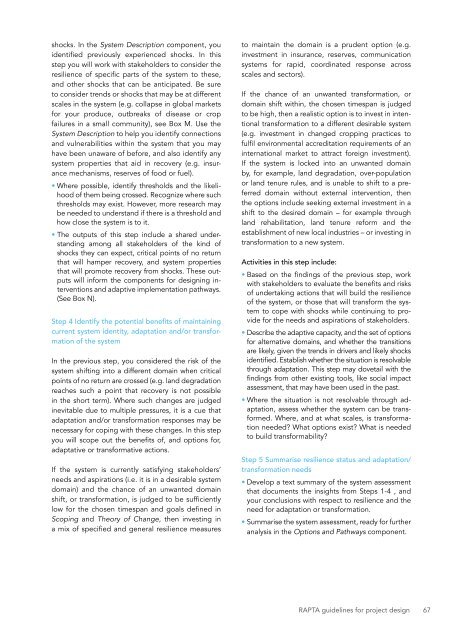DESIGNING PROJECTS IN A RAPIDLY CHANGING WORLD
srun3013fp1
srun3013fp1
Create successful ePaper yourself
Turn your PDF publications into a flip-book with our unique Google optimized e-Paper software.
shocks. In the System Description component, you<br />
identified previously experienced shocks. In this<br />
step you will work with stakeholders to consider the<br />
resilience of specific parts of the system to these,<br />
and other shocks that can be anticipated. Be sure<br />
to consider trends or shocks that may be at different<br />
scales in the system (e.g. collapse in global markets<br />
for your produce, outbreaks of disease or crop<br />
failures in a small community), see Box M. Use the<br />
System Description to help you identify connections<br />
and vulnerabilities within the system that you may<br />
have been unaware of before, and also identify any<br />
system properties that aid in recovery (e.g. insurance<br />
mechanisms, reserves of food or fuel).<br />
• Where possible, identify thresholds and the likelihood<br />
of them being crossed. Recognize where such<br />
thresholds may exist. However, more research may<br />
be needed to understand if there is a threshold and<br />
how close the system is to it.<br />
• The outputs of this step include a shared understanding<br />
among all stakeholders of the kind of<br />
shocks they can expect, critical points of no return<br />
that will hamper recovery, and system properties<br />
that will promote recovery from shocks. These outputs<br />
will inform the components for designing interventions<br />
and adaptive implementation pathways.<br />
(See Box N).<br />
Step 4 Identify the potential benefits of maintaining<br />
current system identity, adaptation and/or transformation<br />
of the system<br />
In the previous step, you considered the risk of the<br />
system shifting into a different domain when critical<br />
points of no return are crossed (e.g. land degradation<br />
reaches such a point that recovery is not possible<br />
in the short term). Where such changes are judged<br />
inevitable due to multiple pressures, it is a cue that<br />
adaptation and/or transformation responses may be<br />
necessary for coping with these changes. In this step<br />
you will scope out the benefits of, and options for,<br />
adaptative or transformative actions.<br />
If the system is currently satisfying stakeholders’<br />
needs and aspirations (i.e. it is in a desirable system<br />
domain) and the chance of an unwanted domain<br />
shift, or transformation, is judged to be sufficiently<br />
low for the chosen timespan and goals defined in<br />
Scoping and Theory of Change, then investing in<br />
a mix of specified and general resilience measures<br />
to maintain the domain is a prudent option (e.g.<br />
investment in insurance, reserves, communication<br />
systems for rapid, coordinated response across<br />
scales and sectors).<br />
If the chance of an unwanted transformation, or<br />
domain shift within, the chosen timespan is judged<br />
to be high, then a realistic option is to invest in intentional<br />
transformation to a different desirable system<br />
(e.g. investment in changed cropping practices to<br />
fulfil environmental accreditation requirements of an<br />
international market to attract foreign investment).<br />
If the system is locked into an unwanted domain<br />
by, for example, land degradation, over-population<br />
or land tenure rules, and is unable to shift to a preferred<br />
domain without external intervention, then<br />
the options include seeking external investment in a<br />
shift to the desired domain – for example through<br />
land rehabilitation, land tenure reform and the<br />
establishment of new local industries – or investing in<br />
transformation to a new system.<br />
Activities in this step include:<br />
• Based on the findings of the previous step, work<br />
with stakeholders to evaluate the benefits and risks<br />
of undertaking actions that will build the resilience<br />
of the system, or those that will transform the system<br />
to cope with shocks while continuing to provide<br />
for the needs and aspirations of stakeholders.<br />
• Describe the adaptive capacity, and the set of options<br />
for alternative domains, and whether the transitions<br />
are likely, given the trends in drivers and likely shocks<br />
identified. Establish whether the situation is resolvable<br />
through adaptation. This step may dovetail with the<br />
findings from other existing tools, like social impact<br />
assessment, that may have been used in the past.<br />
• Where the situation is not resolvable through adaptation,<br />
assess whether the system can be transformed.<br />
Where, and at what scales, is transformation<br />
needed? What options exist? What is needed<br />
to build transformability?<br />
Step 5 Summarise resilience status and adaptation/<br />
transformation needs<br />
• Develop a text summary of the system assessment<br />
that documents the insights from Steps 1-4 , and<br />
your conclusions with respect to resilience and the<br />
need for adaptation or transformation.<br />
• Summarise the system assessment, ready for further<br />
analysis in the Options and Pathways component.<br />
RAPTA guidelines for project design 67


